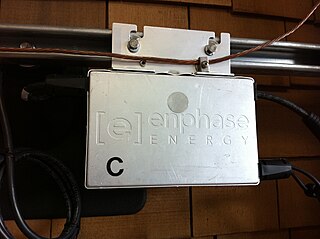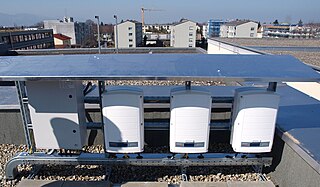
Photovoltaics (PV) is the conversion of light into electricity using semiconducting materials that exhibit the photovoltaic effect, a phenomenon studied in physics, photochemistry, and electrochemistry. The photovoltaic effect is commercially used for electricity generation and as photosensors.
In the 19th century, it was observed that the sunlight striking certain materials generates detectable electric current - the photoelectric effect. This discovery laid the foundation for solar cells. Solar cells have gone on to be used in many applications. They have historically been used in situations where electrical power from the grid was unavailable.

A solar cell panel, solar electric panel, photo-voltaic (PV) module or solar panel is an assembly of photo-voltaic cells mounted in a framework for installation. Solar panels use sunlight as a source of energy to generate direct current electricity. A collection of PV modules is called a PV panel, and a system of PV panels is called an array. Arrays of a photovoltaic system supply solar electricity to electrical equipment.

A photovoltaic system, also PV system or solar power system, is an electric power system designed to supply usable solar power by means of photovoltaics. It consists of an arrangement of several components, including solar panels to absorb and convert sunlight into electricity, a solar inverter to convert the output from direct to alternating current, as well as mounting, cabling, and other electrical accessories to set up a working system. It may also use a solar tracking system to improve the system's overall performance and include an integrated battery.
A power optimizer is a DC to DC converter technology developed to maximize the energy harvest from solar photovoltaic or wind turbine systems. They do this by individually tuning the performance of the panel or wind turbine through maximum power point tracking, and optionally tuning the output to match the performance of the string inverter. Power optimizers are especially useful when the performance of the power generating components in a distributed system will vary widely, such as due to differences in equipment, shading of light or wind, or being installed facing different directions or widely separated locations.

A solar micro-inverter, or simply microinverter, is a plug-and-play device used in photovoltaics that converts direct current (DC) generated by a single solar module to alternating current (AC). Microinverters contrast with conventional string and central solar inverters, in which a single inverter is connected to multiple solar panels. The output from several microinverters can be combined and often fed to the electrical grid.

SolarEdge is an Israeli company that develops and sells solar inverters for photovoltaic arrays, energy generation monitoring software, battery energy storage products, as well as other related products and services to residential, commercial and industrial customers. Established in 2006, the company also has offices in Germany, Italy, Japan, and United States. It is incorporated in Delaware. The company was the first to successfully commercialize power optimizers, a device that offers module-level maximum power point tracking (MPPT), before feeding back the electricity generated into a central inverter.

eIQ Energy, Inc. is a venture-backed Silicon Valley startup that designs and manufactures power electronics for solar photovoltaic systems. The company's Parallel Solar technology, built around the vBoost DC converter module, is intended to reduce overall system costs and enable a true parallel architecture, benefiting system designers, installers and operators. eIQ Energy was founded in 2007 and is headquartered in Santa Clara, California.

A rooftop solar power system, or rooftop PV system, is a photovoltaic (PV) system that has its electricity-generating solar panels mounted on the rooftop of a residential or commercial building or structure. The various components of such a system include photovoltaic modules, mounting systems, cables, solar inverters and other electrical accessories.
SolarBridge Technologies (SolarBridge) is a provider of solar micro-inverter, solar inverter for photovoltaic arrays. These types of products aim to increase energy harvest and reliability while reducing the cost of solar installations and maintenance for residential and commercial markets. The company was acquired by solar panel manufacturer SunPower in autumn of 2014. In 2018 SunPower sold the former SolarBridge microinverter business to Enphase Energy.

Tigo Energy is an American private corporation, headquartered in Campbell, California, United States. It provides products, technologies, software, and services to installers, distributors, and original equipment manufacturers within the photovoltaic industry. It specializes in module-level power optimizers and smart module power electronics.
Enphase Energy is an American energy technology company headquartered in Fremont, California that develops and manufactures solar micro-inverters, battery energy storage, and EV charging stations primarily for residential customers. Enphase was established in 2006 and is the first company to successfully commercialize the micro-inverter, which converts the direct current (DC) power generated by a solar panel into grid-compatible alternating current (AC) for use or export. As of December 31, 2021, the company had shipped more than 42 million micro-inverters to 1.9 million solar systems in more than 130 countries.
Potential-induced degradation (PID) is a potential-induced performance degradation in crystalline photovoltaic modules, caused by so-called stray currents. This effect may cause power loss of up to 30 percent.
A three-phase-inverter is a type of solar microinverter specifically design to supply three-phase electric power. In conventional microinverter designs that work with one-phase power, the energy from the panel must be stored during the period where the voltage is passing through zero, which it does twice per cycle. In a three phase system, throughout the cycle, one of the three wires has a positive voltage, so the need for storage can be greatly reduced by transferring the output of the panel to different wires during each cycle. The reduction in energy storage significantly lowers the price and complexity of the converter hardware, as well as potentially increasing its expected lifetime.
Hanergy Holding Group Ltd. (Hanergy) is a Chinese multinational company headquartered in Beijing. The company is focusing on thin-film solar value chain, including manufacturing and solar parks development. It also owns the Jinanqiao Hydroelectric Power Station and two wind farms.
Younicos was a German-American technology company that developed and sold energy storage systems and control software. The company integrated battery technologies, power electronics and control software to create systems that respond to the energy management requirements of power networks of all sizes, including micro-grids.

Zep Solar was a manufacturer of mounting and grounding equipment for photovoltaic solar energy generation systems. The company was founded in 2009 in San Rafael, California. In 2013, Zep Solar was acquired by SolarCity, which was, at the time, the largest solar power installer in the United States. Zep Solar operated as an independent business unit until SolarCity was acquired by Tesla, Inc. in 2016, at which time Zep Solar was merged into the company's Tesla Energy subsidiary.

Vikram Solar Limited is an Indian company based in Kolkata, the largest solar module manufacturer in India with 2.5 GW module manufacturing capacity annually and the second-largest solar energy company in India by revenue. The company's primary business focus is manufacturing solar PV modules and also carries out engineering, procurement and construction services and operations & maintenance of solar power plants.

Photovoltaic system performance is a function of the climatic conditions, the equipment used and the system configuration. PV performance can be measured as the ratio of actual solar PV system output vs expected values, the measurement being essential for proper solar PV facility's operation and maintenance. The primary energy input is the global light irradiance in the plane of the solar arrays, and this in turn is a combination of the direct and the diffuse radiation.











